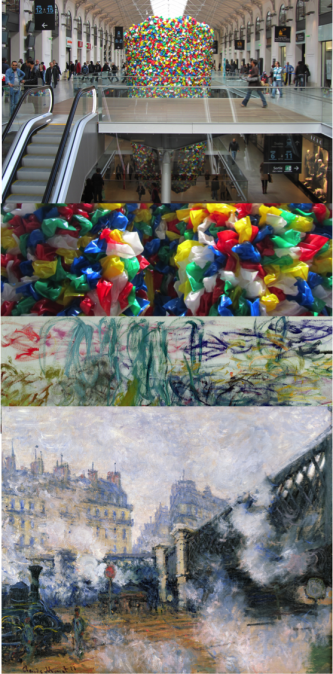A collective realization, by SNCF agents and voluntary travelers, in the heart of the largest commercial space ever opened in France, in Paris Saint-Lazare station.
Pascale Marthine Tayou
Born in 1976 in Yaoundé (Cameroon), lives and works in Ghent (Belgium).

First look
Under the direction of “Workshop Manager” and Cameroonian artist Pascale Marthine Tayou, about 25,000 multicolored plastic bags were knotted on a monumental net, one by one, by a chain of hundreds of volunteers, passengers and SNCF agents from the railway station. Paris-St Lazare. Suspended in the atrium of the station, Plastic Bags was realized from 15 to 21 May 2012 thanks to a collective performance, never seen in France on this scale.
Second look
Like the station, Plastic Bags is like a hive, a heart pulsating crowds of travelers to the “beat” of a train every 28 seconds. At the heart of the largest commercial space ever opened in France at a station, the work of Pascale Marthine Tayou symbolically completes this “works of the decade” for SNCF.
Look at history
Plastic Bags, it is also an unexpected encounter with Claude Monet, who had planted for the first time his easel facing the quays of the St-Lazare station, in 1877, gaining the temporary stop of the trains departing for Normandy. Curious about their times and their industrial and urban transformations, Pascale Marthine Tayou and Claude Monet also share a singular vision of the world, perceived as touches of color and flooded with light.
Look at our society
Through the emblematic object of our everyday consumption, the plastic bag, Pascale Marthine Tayou questions the multitude of “butterfly effects” that our individual consumption generates every day on the world: natural, energy, human resources that we request, recycling techniques we develop, places on Earth today in danger.





